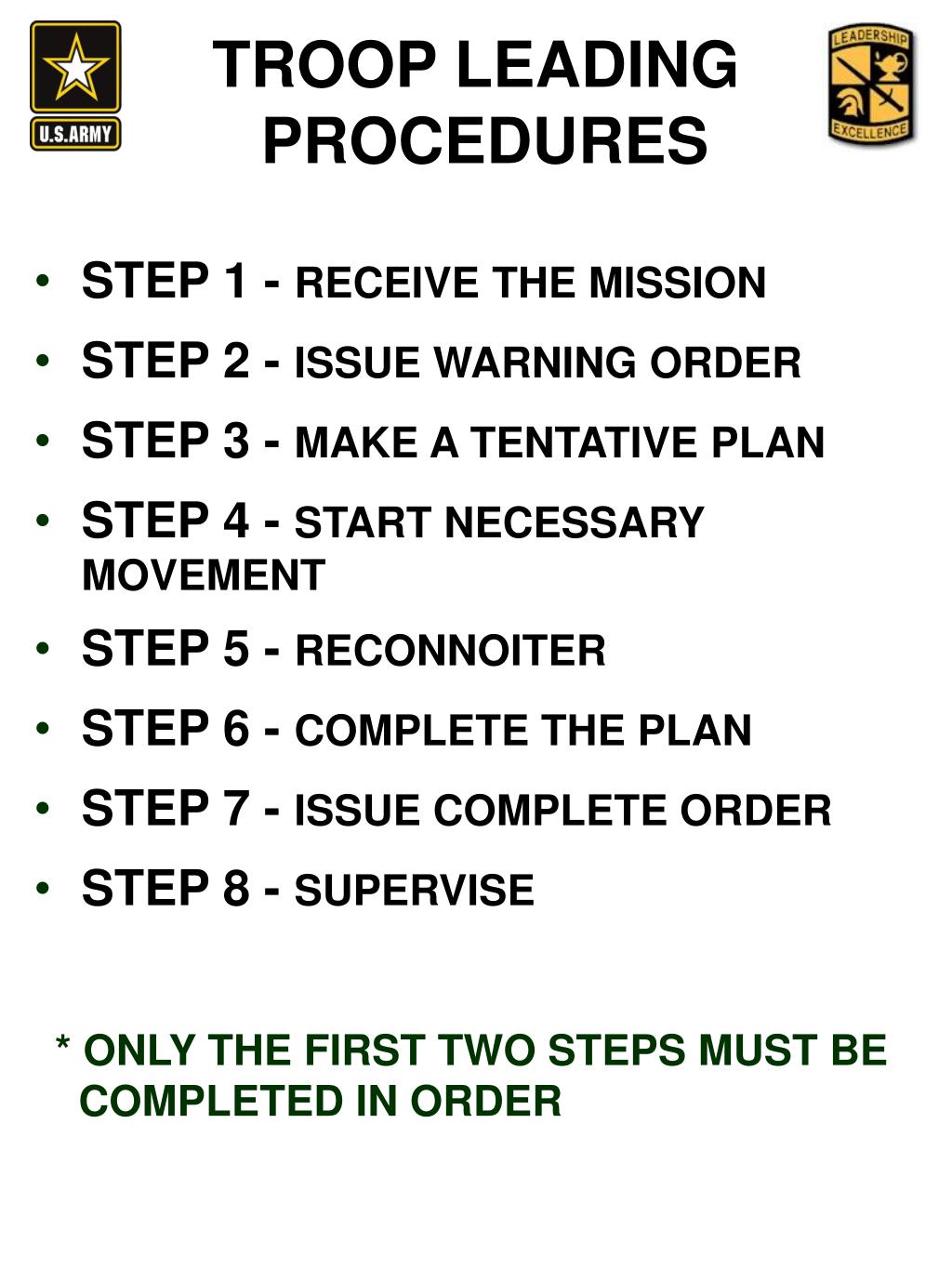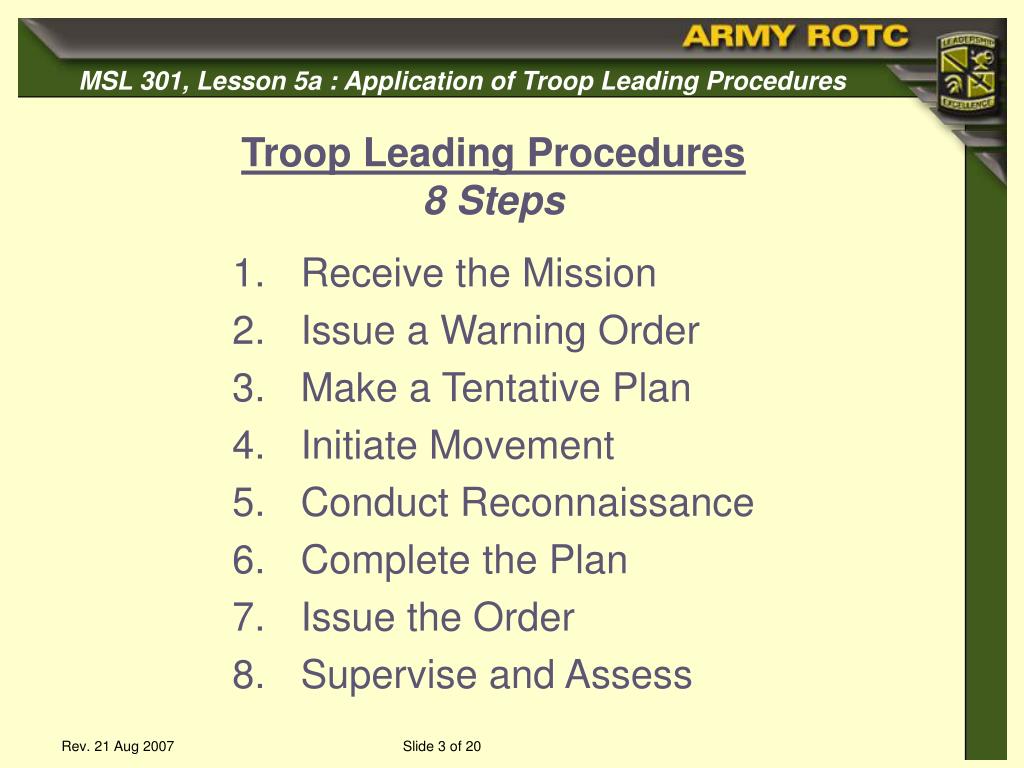Master TLP: Your Guide To Military Mission Success
Are you prepared to navigate the complexities of modern military operations? Troop Leading Procedures (TLPs) are not merely a set of guidelines, but a dynamic framework that underpins mission success from the initial concept to the final assessment, making them absolutely crucial for effective leadership.
In the crucible of contemporary warfare, the ability to adapt, to plan meticulously, and to execute flawlessly can be the difference between triumph and defeat. Troop Leading Procedures, or TLPs, provide a structured and adaptable methodology that empowers military leaders at all levels to achieve these objectives. From the platoon leader receiving the first inkling of an upcoming mission to the final assessment of its execution, TLPs serve as a guiding light, ensuring that every aspect of the operational process is considered, coordinated, and communicated effectively. This systematic approach is not just beneficial; it's indispensable.
The foundation of TLPs lies in their structured approach. While the Military Decision Making Process (MDMP) serves as the primary planning process for commanders with coordinating staffs, TLPs offer a streamlined, eight-step methodology that can be adapted to a wide range of situations. These eight steps are not rigid protocols, but rather a flexible roadmap, allowing leaders to tailor their approach based on the specific circumstances and challenges of the mission. The process begins when the platoon leader receives the mission and continues throughout the operational process. This ensures a consistent and comprehensive approach to planning and execution. But why is this structure so important? Because in the chaos of battle, a clear, well-defined plan becomes a sanctuary of order, allowing leaders to make informed decisions under pressure and to guide their teams with unwavering confidence.
- Breaking Diddy Indictment Criminal Enterprise Sex Trafficking Allegations
- Netspend Latest News Net Worth Insights 20242025
Let's delve into the specifics of these steps. The initial step, receiving the mission, is the critical starting point. It's where the platoon leader first understands the task at hand, the objectives to be achieved, and the constraints within which they must operate. Following this crucial first step, the leader embarks on a journey to analyze the situation, conduct reconnaissance, develop a preliminary plan, initiate movement, make a final decision, supervise and refine the plan, and conduct rehearsals. Each step is designed to ensure that every aspect of the mission is carefully considered and executed.
The implementation of TLPs also requires a strong understanding of communication and collaboration. As leaders progress through the steps, they must effectively disseminate information to their teams, ensuring that everyone understands their role and how their actions contribute to the overall mission success. Briefings, rehearsals, and inspections become critical tools in this process, providing soldiers with a clear understanding of the plan, the expected challenges, and the resources available to overcome them. This is especially important at the joint readiness training center (JRTC) where the need to investigate TLPs was first recognized by members of the Warrior Leadership Council.
Consider the value of a well-orchestrated plan in high-stakes situations. TLPs don't just offer a framework; they provide a systematic way of thinking and solving problems. They empower leaders to analyze the operational environment, evaluate potential courses of action, and select the optimal approach. This is not just about following a checklist; it's about developing a strategic mindset, an ability to anticipate challenges, and make quick adjustments when needed. By mastering TLPs, leaders cultivate a sense of readiness and adaptability that can be invaluable in any military environment, in any climate, and in any complex situation.
- Fox Murray Funeral Home Recent Obituaries Service Details Find Info
- Discover Steve Howey Movies Shows More A Deep Dive
The ability to effectively plan and execute operations is a defining characteristic of a successful military leader, and Troop Leading Procedures are the cornerstone of this skill. They help leaders not just react to the situation, but shape it. By understanding how TLPs work and embracing their importance, leaders can ensure the success of their teams and the achievement of their objectives, from the most basic exercises to the most complex campaigns.
The key element to success is to develop and train the leaders in their ability to effectively plan and execute missions. This approach reinforces the need for military leaders to adopt a systematic approach to preparing their units for any mission. It encourages them to analyze the situation, develop a viable plan, and ensure that this plan is clear, concise, and well-understood by every member of the team. By embracing TLPs, leaders equip their teams to face challenges head-on.
Consider the importance of knowing which publication covers the specifics of TLPs, which are essential for success. This isn't just about following orders; it's about building a culture of professionalism, discipline, and unwavering dedication to the mission.
Let's address some misconceptions. Not every step of the TLP must be done in order. The steps offer a structured approach, but leaders must be flexible and adaptable. It's about the process, not rigid adherence. From the start to the finish of any military operation, the ability to think through, understand and execute each step will prove invaluable to the overall mission.
The Troop Leading Procedures (TLP) provide a systematic approach that will give military leaders a solid foundation for planning and executing missions effectively. From the beginning to the end of the operation, TLPs are there, every step of the way. A well planned operation with a clear direction is a key to success.
TLPs aren't just for commanders or high-ranking officers. They provide a structured and adaptable approach to all echelons. From the small team leader on the front lines, to the company commander, TLP gives leaders the structure needed. From the initial mission to the completion of the task, TLPs empower you to lead effectively and efficiently.
The understanding of TLPs is critical to maintain operational readiness. By using TLPs, military leaders are able to develop and implement plans. It's an essential approach in ensuring operational success. TLPs are the cornerstone of military leadership, a process that starts when a leader receives the mission and continues throughout the entire operational process.
From the moment the platoon leader receives their mission, the process begins. The eight steps are designed to ensure a comprehensive approach to planning and execution. Every aspect of a mission from preparing, to executing, and finally assessing the mission requires leaders to be familiar with TLPs. Briefings, rehearsals, and inspections are all critical parts of the process.
| Key Aspect | Details |
|---|---|
| Focus | Structured framework for military leaders to plan and execute missions effectively. |
| Initiation | Begins when a leader receives the first indication of an upcoming mission. |
| Scope | Continues throughout the operational process: Plan, Prepare, Execute, and Assess. |
| Adaptability | Eight steps that can be flexible and adapted to different situations. |
| Relationship with MDMP | Similar to MDMP (Military Decision Making Process) but not identical. MDMP is used by commanders with a coordinating staff. |
| Importance | Ensures mission success by helping leaders analyze situations, develop plans, and communicate them clearly. |
| Key Components | Includes briefs, rehearsals, and inspections to ensure soldiers understand the mission. |
| Purpose | To provide a systematic approach that enables leaders to plan and execute missions effectively and efficiently. |
| Outcome | Mastering TLPs is essential for maintaining readiness, adaptability, and operational success in any military environment. |
To deepen your knowledge and understanding, refer to the following resources: Official U.S. Army Website



Detail Author:
- Name : Alex Doyle
- Username : brekke.rosemarie
- Email : rhianna.rempel@kessler.org
- Birthdate : 1975-11-08
- Address : 995 Hansen Ports Suite 336 Tremblaymouth, FL 24562-4882
- Phone : 205.626.2241
- Company : Halvorson-Crooks
- Job : Paving Equipment Operator
- Bio : Nostrum quia nisi sed eius consequatur saepe. Id at et quis incidunt at. Alias ea corporis necessitatibus. Assumenda quam omnis corrupti quia quo tenetur alias quia.
Socials
facebook:
- url : https://facebook.com/cschaefer
- username : cschaefer
- bio : Sint sint vitae sit minima ab pariatur voluptas tempore.
- followers : 4046
- following : 1923
twitter:
- url : https://twitter.com/schaeferc
- username : schaeferc
- bio : Est earum accusamus qui dolorem. Nihil enim ut et. Libero voluptatum earum maxime sint. Omnis id sint distinctio velit repellendus molestias temporibus soluta.
- followers : 1925
- following : 1263